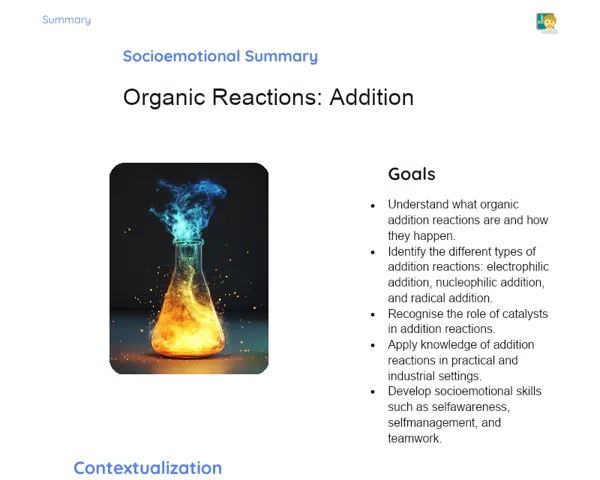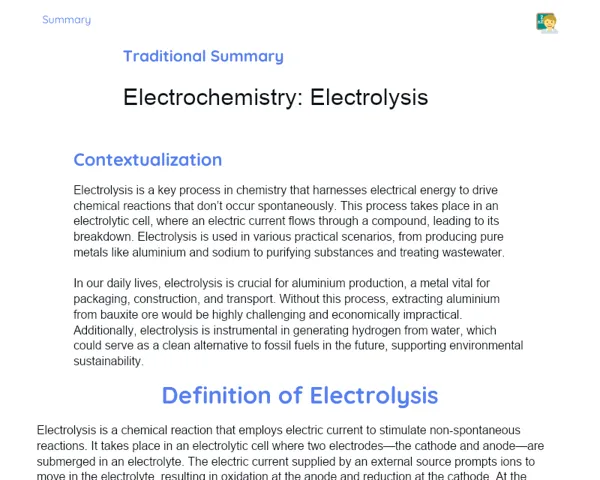Summary Tradisional | Organic Functions: Alcohol Nomenclature
Contextualization
Alcohols are a group of organic compounds that we encounter often in our daily lives. They feature a hydroxyl group (-OH) bonded to a saturated carbon, giving them specific chemical and physical traits. A familiar example is ethanol, which is commonly found in alcoholic drinks and is also used as a biofuel. Another example is propanol, often found in disinfectants and cleaning products. Grasping the nomenclature of these substances is crucial not only for effective scientific communication but also for understanding their functions and how they’re applied in industry.
The naming of alcohols adheres to the guidelines set forth by IUPAC (International Union of Pure and Applied Chemistry), which standardizes chemical nomenclature to promote clear and precise interactions among chemists globally. Besides just learning how to name alcohols, it’s important to differentiate them from other organic compounds, such as methanol, which possess unique properties and purposes. Recognizing these distinctions is key to preventing misunderstandings and for applying alcohols accurately, whether it’s in beverage production or manufacturing.
To Remember!
Definition of Alcohols
Alcohols are organic compounds characterized by a hydroxyl functional group (-OH) attached to a saturated carbon atom (sp3). This hydroxyl group is pivotal in determining the chemical and physical properties of alcohols. The carbon linked to the hydroxyl group must be saturated, indicating it only has single bonds with other atoms.
Understanding the definition of alcohols is essential to differentiate them from other organic compounds containing oxygen in their structure, such as ethers and carboxylic acids. The presence of the hydroxyl group lends alcohols their polar nature, ability to form hydrogen bonds, and their solubility in water, particularly among short-chain alcohols.
Additionally, the placement of the hydroxyl group along the carbon chain can greatly affect an alcohol's properties. Different types—primary, secondary, and tertiary alcohols—show varied reactivities and boiling points based on how the hydroxyl group interacts with the rest of the molecule.
-
Alcohols have a hydroxyl group (-OH) attached to a saturated carbon (sp3).
-
Understanding alcohols helps differentiate them from other organic compounds containing oxygen.
-
The position of the hydroxyl group in the carbon chain influences the properties of the alcohol.
IUPAC Nomenclature of Alcohols
The naming of alcohols as per IUPAC follows specific guidelines to ensure the names of chemical compounds remain standardized. The initial step is to locate the longest carbon chain that incorporates the hydroxyl group. This chain is numbered so that the hydroxyl group receives the lowest feasible number.
Once numbered, the alcohol’s name is formed from the related hydrocarbon, swapping the '-o' ending for '-ol'. For example, methane transforms into methanol once a hydroxyl group is attached. If there are branches or other groups on the main chain, these must be named and numbered according to their locations within the chain.
Moreover, prefixes like 'di-', 'tri-', and so forth are used if there’s more than one hydroxyl group present in the molecule. For instance, ethylene glycol comprises two hydroxyl groups in a two-carbon chain. IUPAC naming serves as a necessary tool for precise dialogue among scientists and for the clear identification of chemical compounds.
-
Identify the longest carbon chain with the hydroxyl group.
-
Number the chain so that the hydroxyl group has the lowest possible number.
-
Change the '-o' ending of the corresponding hydrocarbon to '-ol'.
Classification of Alcohols
Alcohols can be sorted into primary, secondary, and tertiary classifications based on the number of carbon atoms linked to the carbon that contains the hydroxyl group. Primary alcohols have the hydroxyl group attached to a carbon that is linked to only one other carbon. Ethanol serves as a prime example.
Secondary alcohols feature the hydroxyl group connected to a carbon that is attached to two other carbon atoms. Isopropanol is an instance of a secondary alcohol. Tertiary alcohols have the hydroxyl group bonded to a carbon that connects to three additional carbons, like tert-butanol.
This classification plays a significant role as it affects the physical and chemical characteristics of alcohols—including their boiling points, solubility in water, and reactivity. For example, tertiary alcohols typically exhibit lower boiling points and are less water-soluble than their primary and secondary counterparts.
-
Primary alcohols have the -OH group attached to a carbon linked to one other carbon.
-
Secondary alcohols have the -OH group attached to a carbon linked to two other carbons.
-
Tertiary alcohols have the -OH group attached to a carbon linked to three other carbons.
Examples and Applications
Alcohols find extensive applications across various industries because of their unique chemical properties. Methanol, for instance, serves as a solvent and is essential for producing formaldehyde, a key industrial chemical. However, it's important to note that methanol is toxic and should never be consumed.
Ethanol, perhaps the most recognized alcohol, is present in alcoholic beverages and utilized as biofuel. In Brazil, ethanol is primarily derived from sugarcane and is widely adopted as an automotive fuel, leading to lower emissions of harmful pollutants.
Propanol and isopropanol are commonly included in cleaning products and disinfectants due to their antibacterial properties. These alcohols efficiently eliminate microorganisms and feature prominently in personal hygiene items, such as hand sanitizers.
-
Methanol is used as a solvent and in the production of formaldehyde.
-
Ethanol is found in alcoholic beverages and serves as a biofuel.
-
Propanol and isopropanol find use in cleaning products and disinfectants.
Key Terms
-
IUPAC Nomenclature: A clear set of guidelines for naming chemical compounds.
-
Hydroxyl Group (-OH): The distinct functional group found in alcohols, linked to a saturated carbon.
-
Primary Alcohols: Compounds where the -OH group links to a carbon connected to only one other carbon.
-
Secondary Alcohols: Compounds where the -OH group attaches to a carbon connected to two other carbons.
-
Tertiary Alcohols: Compounds where the -OH group resides on a carbon linked to three other carbons.
-
Methanol: The simplest form of alcohol, used as a solvent and for producing formaldehyde.
-
Ethanol: An alcohol prevalent in both alcoholic beverages and as a biofuel.
-
Propanol: An alcohol often employed in disinfectants and cleaning agents.
-
Biofuels: Renewable fuels derived from organic materials, such as ethanol.
Important Conclusions
In this lesson, we explored the definition and classification of alcohols, highlighting the significance of the hydroxyl group (-OH) bonded to a saturated carbon. We learned how this structure affects the chemical and physical attributes of alcohols, distinguishing them from other organic compounds.
We reviewed the IUPAC nomenclature rules for alcohols, focusing on identifying and naming carbon chains that contain the hydroxyl group, as well as distinguishing between primary, secondary, and tertiary alcohols. This standardization proves essential for effective scientific communication and for understanding the characteristics of chemical compounds.
Furthermore, we examined practical examples and applications of alcohols, such as methanol, ethanol, and propanol, underscoring their relevance in both industry and daily life. A solid grasp of these applications reinforces the need to master the nomenclature and classification of alcohols, aiding safe and effective use of these substances in various settings.
Study Tips
-
Familiarize yourself with IUPAC nomenclature rules for alcohols and practice naming different compounds using tables and exercises.
-
Learn about the categorization of alcohols (primary, secondary, and tertiary) and look for examples in your everyday environment. Compare their physical and chemical properties to deepen your understanding.
-
Investigate the real-world applications of alcohols in various industries and daily life. Read articles and watch videos on the production and use of biofuels, solvents, and disinfectants to contextualize your theoretical knowledge.



